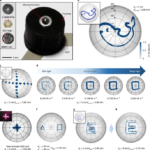An aquatic-vision-inspired camera based on a monocentric lens and a silicon nanorod photodiode array
Conventional wide-field-of-view cameras consist of multi-lens optics and flat image sensor arrays, which makes them bulky and heavy. As a result, they are poorly suited to advanced mobile applications such as drones and autonomous vehicles. In nature, the eyes of aquatic animals consist of a single spherical lens and a highly sensitive hemispherical retina, an approach that could be beneficial in the development of synthetic wide-field-of-view imaging systems. Here, we report an aquatic-vision-inspired camera that consists of a single monocentric lens and a hemispherical silicon nanorod photodiode array. The imaging system features a wide field of view, miniaturized design, low optical aberration, deep depth of field and simple visual accommodation. Furthermore, under vignetting, the photodiode array enables high-quality panoramic imaging due to the enhanced photodetection properties of the silicon nanorod photodiodes.
Learn about our two Decals!
 Click here to find out more about our Fall Bioinspired Design Decal and our Spring Bioinspired Design in Action Decal – ALL MAJORS are welcome.
Click here to find out more about our Fall Bioinspired Design Decal and our Spring Bioinspired Design in Action Decal – ALL MAJORS are welcome.Berkeley BioDesign Community
 Click here to learn about the BioD: Bio-Inspired Design @ Berkeley student organization or here to signup for more info.
Click here to learn about the BioD: Bio-Inspired Design @ Berkeley student organization or here to signup for more info.Search
Student Login






I imagine that the neurological circuits underlying these processes are governed by both 2d spacing maps with their brains as…
to reduce the impact of car accidents, it may be possible to study the force diverting physics of cockroaches to…
you see this type of head-bobbing stability in many avian creatures related to pigeons like chickens. the head ability to…
not like they taught horses how to run! this is an example of convergent evolution where both sea creatures and…
The brain functions in a similar way with neuronal connections. our brains are able to utilize the multiplicity of connections…